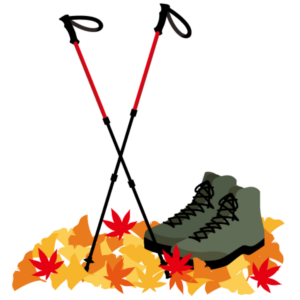BUNCOMBE COUNTY, NC – Summertime, 2024 – This is a great time of year to go for a hike in the mountains around Asheville. Hiking provides many health benefits like lowering the risk of heart disease, reducing blood pressure, and strengthening cardiovascular fitness. Hiking can range from a leisurely low-intensity activity to a very strenuous high-intensity workout on mountainous terrain. Many hikers carry supplies like water, food, clothing, and a tent, particularly on longer routes that can last for more than a day. Carrying heavy loads put a greater stress on muscles and joints and increase energy needs and fatigue. Overuse and traumatic injuries can occur with hiking, such as fractures and sprains.
Walking with poles originated in Finland. This activity is time-efficient, low-stress, and a total body workout. It has spread to many countries in Europe and the United States. Hiking with poles is both accessible and cost-effective. The poles are referred to as hiking poles, Nordic walking poles, and trekking poles. They may be made of light aluminum or carbon fiber.
Many people use specially designed trekking poles to help them hike. These hikers feel that the poles help with balance, stability, and offloading their lower extremities. An article published in Wilderness & Environmental Medicine in 2020 reviewed the medical literature over the preceding 40 years. This review found that hikers can walk faster with poles. During unloaded walking, trekking poles improved balance, decreased lower extremity loads, when going downhill and on level ground, but required more cardiovascular effort. With carrying higher loads, the poles increased balance and stability when hiking. Poles act as an accessory brake when going downhill and reduce leg muscle activity and leg soreness afterwards. The hikers with loads had a more normal walking pattern though expended more effort. However, there was no difference in cardiovascular effort when compared to hikers not carrying loads. The authors did not find any evidence supporting the use of one pole versus two poles when hiking.
Hiking with poles has also been shown have beneficial health affects for special populations like persons with Parkinson’s disease, obesity, low back pain, and the elderly. In Parkinson and elderly patients, using poles help facilitate a better coordinated gait pattern, better balance, and a faster gait. In obese persons, using poles can offload their lower extremity joints and reduce the risk of the development of osteoarthritis. Hiking with poles can offload the spine and temporarily reduce low back pain in persons suffering from this ailment.
Hiking with poles is an activity that can improve safety, reduce joint stress, give you a better overall workout, and improve endurance in contrast to hiking without poles. The authors concluded that hiking poles should be considered if the hiker has any pre-existent lower extremity conditions or pain. However, persons using trekking poles should understand that the poles will stress their cardiovascular fitness and their upper body more than not using them. You will burn 20% more calories if you use poles; and you will walk faster too.
Listen to the full report below:
Contact: Dr. Dick Needleman, Health reporter, 103.3 AshevilleFM, [email protected]
More Posts for Show: Asheville FM News Hour
